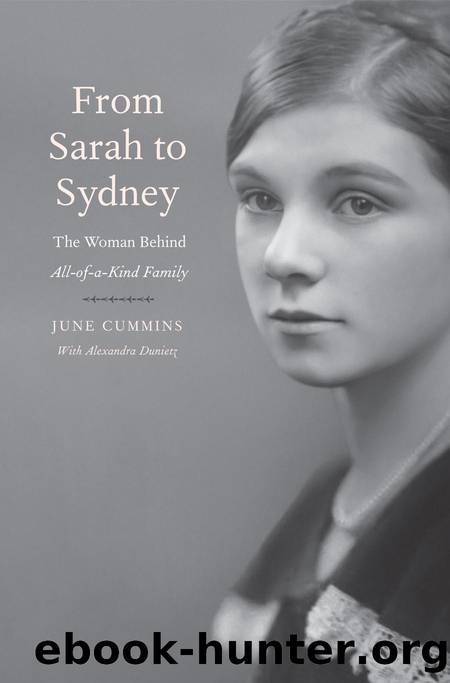From Sarah to Sydney by June Cummins

Author:June Cummins
Language: eng
Format: epub
ISBN: 9780300243550
Publisher: Yale University Press
NINE
Camp Cejwin
1942â1960
BEGINNING IN 1942, TAYLOR JOINED ELLA as an employee of Camp Cejwin, in Port Jervis, New York, ninety minutes from Manhattan by train. Cejwin was founded in 1921 under the auspices of the Central Jewish Institute (CJI), and by the early 1940s it was a flourishing institution in constant expansion. Through Ellaâs connection to the CJI in Manhattan in the early 1930s, all of the Brenner sisters eventually worked in some capacity for the camp, several for decades, and some of their children later worked as counselors.1 Until the mid-1970s, Taylor served as the drama and dance director of the Hadas camp for younger girls (ages seven to eleven), writing new plays and pageants each year, in addition to choreographing dances and directing performances. Her summers at Cejwin combined many strands of her life: attachment to her sisters, involvement in progressive education, interest in molding a Jewish American life, and experimentation with artistic expression. Because she went to Cejwin for so long and had similar experiences summer after summer, this chapter occasionally jumps ahead chronologically, before returning to 1950 and Taylorâs transformation into an award-winning author.
Complementing the role of public schools in the Americanization of immigrants, Jewish summer camps shared a primary goal of nonsectarian American camps, which was to raise healthy, independent citizens. In the years after World War II, as many as one in six camper-age children attended camp each summer, so the impact on American childhood was significant.2 For Jews, summer camps also became places to promote knowledge of and pride in Jewish culture and to reshape tradition for their modern American children. The historian Jonathan Krasner has shown that the rise of Jewish âcultural campingâ was guided by an innovative group of educators, the so-called Benderly Boys, whose mentor and teacher was Samson Benderly (1876â1944), who in turn was greatly influenced by John Dewey. Albert P. Schoolman (1894â1980), the founder of the CJI and of Camp Cejwinâand later, Ellaâs husbandâwas one of Benderlyâs disciples. The camp Schoolman created exemplified some of the ideas of Dewey and other progressives that were familiar to Taylor from the Bank Street School and the Little Red School House.
As mentioned, the massive immigration the Brenners took part in led to overcrowded cities, with their attendant poverty, disease, and crime. Social reformers and philanthropists eyed vacation camps in the country as yet another mechanism for social progress, allowing poor urban children to escape to the fresh air, thereby both benefiting public health and reducing delinquency. Often motivated by epidemics of influenza and polio, Jewish philanthropists and organizations subsidized that goal of safeguarding childrenâs health. Trends discussed earlier about progressive education surfaced in these summer camps, including an emphasis on direct experience, on the development of the whole child, and on democratic relations among teachers and students.
By the 1930s, Jewish camps were a mass phenomenon for all socioeconomic groups. Just as it became hard to define a mainstream âAmericanâ camp, as the initial antimodern institutions that romanticized the great outdoors and frontier
Download
This site does not store any files on its server. We only index and link to content provided by other sites. Please contact the content providers to delete copyright contents if any and email us, we'll remove relevant links or contents immediately.
The Power of Myth by Joseph Campbell & Bill Moyers(1014)
Half Moon Bay by Jonathan Kellerman & Jesse Kellerman(955)
Inseparable by Emma Donoghue(937)
A Social History of the Media by Peter Burke & Peter Burke(936)
The Nets of Modernism: Henry James, Virginia Woolf, James Joyce, and Sigmund Freud by Maud Ellmann(836)
The Spike by Mark Humphries;(766)
The Complete Correspondence 1928-1940 by Theodor W. Adorno & Walter Benjamin(751)
A Theory of Narrative Drawing by Simon Grennan(742)
Culture by Terry Eagleton(724)
Ideology by Eagleton Terry;(696)
Bodies from the Library 3 by Tony Medawar(683)
World Philology by(678)
Farnsworth's Classical English Rhetoric by Ward Farnsworth(674)
Game of Thrones and Philosophy by William Irwin(671)
High Albania by M. Edith Durham(659)
Adam Smith by Jonathan Conlin(649)
A Reader’s Companion to J. D. Salinger’s The Catcher in the Rye by Peter Beidler(647)
Comic Genius: Portraits of Funny People by(616)
Monkey King by Wu Cheng'en(611)
